Reviews
Tom Clancy’s The Division
April 20, 2016, Author: James Sheppard
Tom Clancy’s The Division has been on the radar of many for a long time. Touted as a potential Destiny-killer, it’s the newest entry in the increasingly popular new-gen pseudo-genre of adding MMO mechanics and persistence to everything – in this case, a third-person shooter. With Ubisoft proudly stating that it’s the fastest-selling new IP ever made based on week one sales – yes, even beating the aforementioned Destiny – there’s no doubt that it’s been a commercial success at the very least.
Initial sales for an MMO are only the first battle of a long war, however. Have Ubisoft and Massive Entertainment laid down a solid enough framework to build on with new content and expansions over the coming months and years? Will the endgame keep players satisfied long after reaching the level cap? Is this even a world you’ll want to spend your time in, anyway? After investing a good chunk of time into The Division since launch, I’m not convinced that I can give a wholly positive answer to any of these questions.
It does start off promisingly, nonetheless. A deadly smallpox virus has spread across New York City, killing untold masses. As an agent of ‘The Division’ within the quarantined Manhattan, you’ve been tasked with trying to restore some semblance of order amongst the panicked survivors and overwhelming hordes of rioters, gangs and other armed criminals wreaking havoc. You’re joined by Faye Lau, a seemingly well-rounded, tough female agent character, just one of the main components of The Division brimming with potential depth in its theoretically interesting game universe.
Then Lau gets injured and sits in a base for the rest of the game whilst you’re sent on fetch quests and other formulaic missions across a progressively repetitive open world. Oh well, can’t have everything, can you?
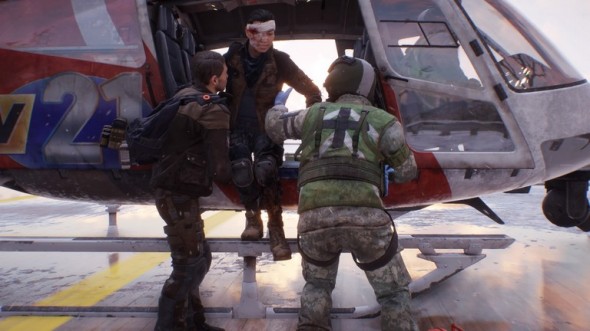
Sigh.
You’re certainly not short of things to do, at least. There’s a selection of main story missions, numerous side-missions, three flavours of extra activities, safe houses to unlock, countless collectibles to track down and emergent incidents which occur spontaneously around the map. This is truly an Ubisoft open world in every sense.
In-between ticking off objectives and map markers, you’ll regularly return to your main base of operations. A makeshift shelter set up within the James A. Farley Post Office Building, it houses a bunch of merchants and three run-down operational wings – Tech, Security and Medical. Completing missions nets you points in one of these three categories, which can be spent on bringing them into some sort of order. The real outcome of this is extra merchants, functionality and new traits which form part of the bread-and-butter of The Division’s RPG-lite systems.
Progressing through the game doesn’t provide you with attribute points to allocate. Instead you gain access to better loot and can assign active abilities to use in battle, passive bonuses to certain attributes, and a range of buffs which are all permanently activated once unlocked – skills, talents, and perks, respectively.
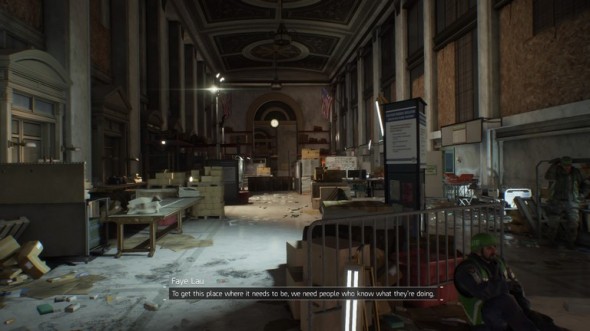
Get this place cleaned up and you’ll be rewarded with goodies.
Something else that sets it apart from a typical RPG structure is that your skills and talents can be re-assigned, penalty-free, at any time. On the plus side, this allows for experimentation whilst avoiding regrettable build decisions. On the other hand, this means there are no real classes or distinction between players – everyone is essentially the same and this parity negates variety. It’s also the case that some skills are more useful than others. You’ll be almost guaranteed to pick a healing ability, and are likely to fill the other slots with a scanning skill and/or one out of a couple of decent offensive powers. Talents have minor, situationally-dependent effects – take less damage for a few seconds after reviving a teammate, for example – and so aren’t overly significant.
With hamstrung character customisation, then, one of your main focuses will be on gear. The weapon and armour system is one aspect in which The Division shines. There are plenty of armour slots to fill out as you please, even down to your rucksack and knee pads, and some of these can be further augmented with mods. You can equip two primary weapons at once, backed up by a secondary, all of which are easy to swap out. These can be significantly buffed with a range of varying scopes, hand grips, magazines and more.
All of the above can be bought from merchants or built via a solid crafting system, but of course the preferred method of acquiring gear is through loot drops. Down some enemies, and there’s a good chance that at least one will drop an item, colour-coded to signify rarity and thus value and effectiveness.
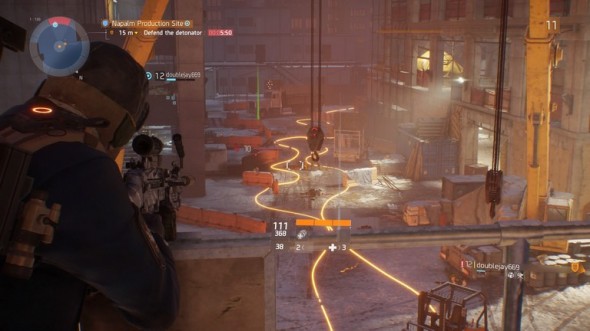
Those beams of light in the distance signify sweet nuggets of loot.
And down enemies you will. The Division is certainly not short of bad guys to kill. Play a story mission and you’ll progress linearly from encounter to encounter, facing opponents of increasing number and difficulty until you polish off a boss at the end. Tackle a side-mission and you might have to fend off waves of attackers in order to protect supplies, or raid a hive of criminals. Hell, just walk down the Manhattan streets and you’ll encounter pockets of baddies itching for a scrap.
As you make your first tentative steps through this crisis-stricken New York, it’s easy to feel a sense of wonder. There’s a large map ready to be explored, so many things to do, so much stuff to collect, but sadly the longer you play, the more this optimism fades and monotony sets in.
Combat is slick and satisfying enough, with tight weapon controls and an intuitive cover system. What’s jarring, however, is the bullet-sponge-like nature of the enemies. Elite foes in particular will soak up a ridiculous number of rounds before finally keeling over. This sort of thing is expected in MMOs, admittedly, but whereas a bulletproof constitution seems feasible for aliens and fantastical beasts, it requires a little more suspension of disbelief when human beings are involved.
Thankfully this high volume of enemies (with their even higher volume of health bars) is compensated for with enormous individual stockpiles of ammo and plentiful munition boxes. Yet constantly pumping whole clips into people becomes a chore. It also lends itself to idiosyncrasies such as needing to inflict a huge amount of damage before an opponent will even flinch. Encounters become less about skill shots and tactics, and more a game of holding down the trigger button constantly. He who fires the most bullets, wins.
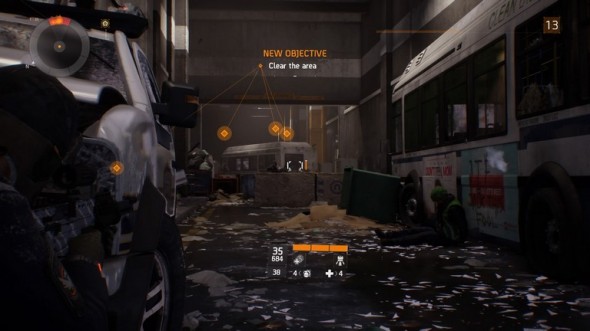
‘New objective: clear the area’. You don’t say?
This functional yet ultimately primitive combat goes hand-in-hand with a formulaic mission structure. 90% of the time, your objective is basically ‘kill everything that moves’. When missions actually divert from this, it’s a case of just walking from point to point in order to investigate an incident or find a missing person. Sometimes you’ll find and explore ‘echoes’, holographic flashbacks of scenarios that occurred at the height of the outbreak. Whilst visually impressive, these distorted orange holograms fail to redeem what are asinine walking quests built on vacuous storylines.
This is a problem with The Division at large: there’s so much to do, but little reason to care about doing any of it. A viral outbreak and post-apocalypse of sorts is a fundamentally rich concept, but the story is set neither within the initial chaos and danger of the outbreak, or far enough into the aftermath that society and Manhattan have devolved to a compelling point of disaster.
Or, at least, the latter is not framed believably. Most exposition is simply delivered over radio dialogue as you go about your man-shooting business. Forgettable character names and faces are briefly introduced then discarded just as quickly. I had to force myself to pay attention to scraps of plot thrown at me, and even then I didn’t really understand or bring myself to give a damn about what was happening.
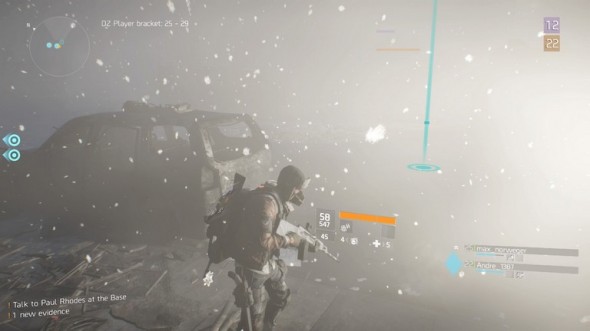
Dat weather, tho.
There’s simply an overwhelming feeling of blandness and dearth of personality. This extends to the visual design, which is nonetheless technically impressive. Environment detail is extensive, lighting models are superb and the overall result is a high level of realism. Perhaps too much realism, as ridiculous as that sounds. Modelling itself somewhat closely on real-life Manhattan, it’s a sea of grey, with some brown thrown in for good measure. Injecting some much-needed pizzazz into the surroundings are the exceptional weather effects. Sometimes the snow and fog descends so heavily, it genuinely obscures your view. To have gameplay impacted by the environment in such a manner is a welcome surprise.
By now you’ll have gathered that The Division can be an underwhelming experience. It doesn’t always have to be that way. In my time spent exploring all of the content available I determined one important rule to play by: never go alone. Soloing missions can be a miserable, soul-crushing affair. Yet, throw a few teammates into the mix and everything changes. That endless tracking from point to point, mindlessly firing off unfathomable chunks of hot lead, lends itself perfectly to co-op play.
Thankfully, there are excellent matchmaking features baked in as standard to facilitate this. Not only does every main story mission automatically pair you up with other players, but a free-roam matchmaking booth exists in the safe house of every district of the city. You can also freely send invites to both agents on your friends list and strangers alike.
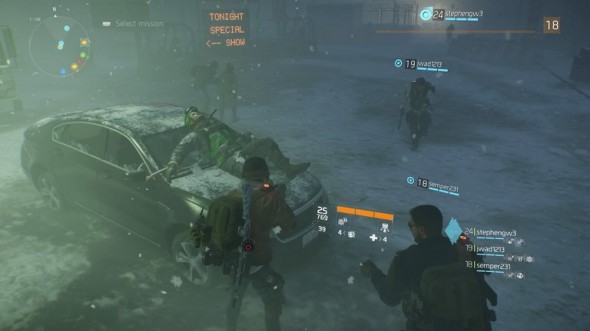
Sharing in murder and mayhem is what friends are for
I genuinely had some wonderful experiences playing through missions and exploring the city with strangers. I even made a few new friends for my PSN list. In the most positive online experience I’ve had in a long time, a high-level player approached me early-on, out of the blue, and kindly took me under his wing to show me the ropes. Moments like this define social gaming.
Of course, this doesn’t wholly excuse gameplay that is technically sound yet creatively deficient. It merely abates it. Additionally, the automatic enemy scaling that occurs in co-op elevates the bullet sponge factor to a ludicrous degree. Get matched with a haphazard motley crew of children, lone wolves and idlers – as happened to me on occasion – and you might as well be playing by yourself for all the frustration it will cause.
In the interest of ending on a high note, I’ve saved The Division’s trump card until last: The Dark Zone. God knows the overall package needed an injection of variety and unpredictability, and this ruthless environment delivers both in spades.
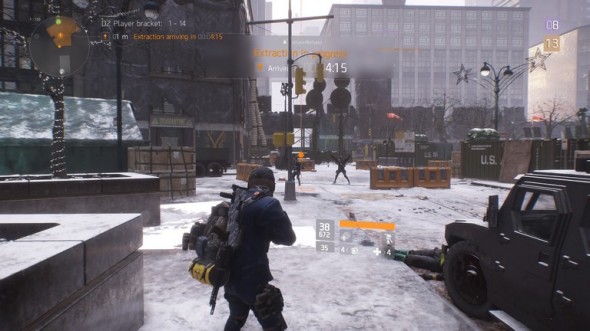
Star-jumping in the Dark Zone is code for ‘I’m friendly’. I soon discovered that this is a cruel lie
A walled-off no-man’s land in the centre of the map, the Dark Zone plays host to both the toughest enemies and the best loot in the game. It’s also, critically, the only area in which PvP is possible. Everyone starts off on neutral territory, save for those who enter as a team. It’s down to each individual whether they avoid human contact, co-operate, or act friendly only to betray others when their backs are turned.
The Dark Zone operates on its own set of distinct rules. You’re given a separate rank independent of your PvE level, a unique currency, and even a dedicated inventory. Play peacefully, and if you’re lucky you’ll be left alone. Shoot other players, however, and you’re branded with a ‘rogue’ marker and a bounty which increases proportionally with your immorality.
Fuelling the fire is the loot system. Enemies drop quality gear, and chests unlocked with special keys are home to the very best which The Division has to offer. Except, all Dark Zone loot by default is ‘contaminated’ and unusable. The only way to access it is through timed helicopter extractions in one of several zones, in which enemies and other players pile in to create a frantic maelstrom of bullets and mortality. Oh, and did I forget to mention that upon death you drop all of your hard-earned loot? Yeah, sorry about that.
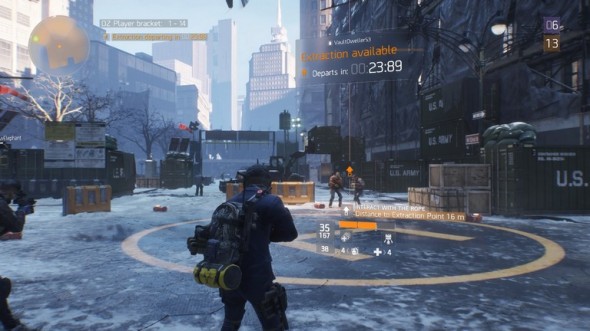
Helicopter’s here! Time to extract loot/get shot and die/rage-quit
These dog-eat-dog circumstances are as deliriously exhilarating as they are downright stressful. Naively stroll into the Dark Zone by yourself and you will be overwhelmed, misled and leaving empty-handed with your tail between your legs. That said, it’s certainly responsible for my strongest memories of the game. I’ll never forget the times I was stabbed in the back, that moment when I accidentally went rogue and got my team killed, and the down-to-the-wire scenarios where I successfully extracted loot at the last second. It’s by far the most original aspect of The Division, albeit essentially a triple-A take on the burgeoning survival genre popularised by the likes of DayZ and Rust.
Divisive by name, divisive by nature
On paper, The Division is a respectable value proposition. There’s a hell of a lot to do for your money, with enough content to easily keep you busy for tens of hours. Get absorbed in the endgame of finding gear with ever-higher numbers on, and that figure could potentially rise into the hundreds. As expected in a game of this style, constant updates with fresh content have also been promised. At the time of writing, the 1.1 patch has just gone live. This introduces a new gear score system, daily and weekly ‘assignment’ challenges, chaotic but rewarding Dark Zone supply drops, and the first of a new Raid-cum-Horde mode: Incursions.
Of course, quantity and quality can be mutually exclusive entities. Each mission is simply a rehash of the last but set in a slightly different location, and the ceaseless, repetitious shooting of every encounter imparts a grating tedium. The Dark Zone is one of The Division’s saving graces, though its compassionless nature won’t appeal to everyone.
The final word is that Tom Clancy’s The Division may not be a true MMO in every sense, but the ‘massively multiplayer’ should not be disregarded. This is an undertaking to be consumed with others. Team up with friends or (competent) strangers and you’ll probably have a good time. Fail to do so, and you’ll find an experience bleaker than a post-apocalyptic New York winter.
Platforms: PC, PS4, Xbox One | Tagged action, co-op, Destiny, Massive Entertainment, MMO, Multiplayer, Online, post-apocalypse, Shooter, The Division, Third Person Shooter, Third-Person, tom clancy, Ubisoft



